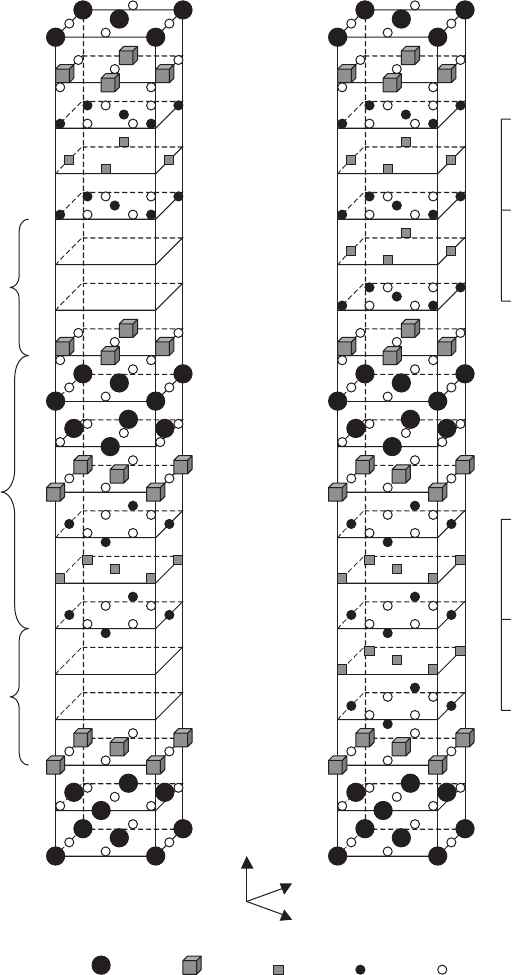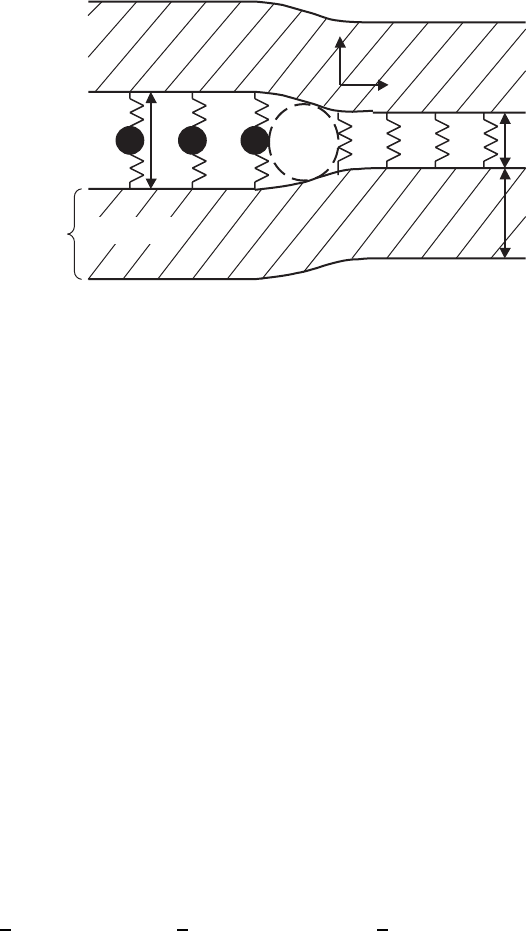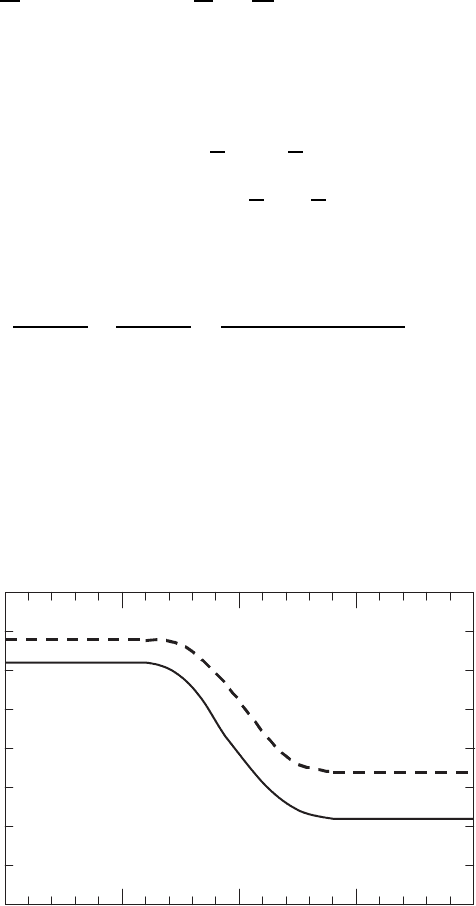Parinov I.A. Microstructure and Properties of High-Temperature Superconductors
Подождите немного. Документ загружается.


6
Modeling of BSCCO Systems and Composites
6.1 Transformation of B i-2212 to Bi-2223 Phase
Understanding the mechanism and kinetics of the Bi-2212-to-Bi-2223 phase
transformation is very important to fabricate Bi-2223 superconductors with
high structure-sensitive properties. The most widely used method of process-
ing Bi-2223 materials is to mix Bi-2212, CaPbO
3
and CuO powders and to
anneal the mixture in a sealed tube at about 830
◦
C during 10–100 h [119].
All models proposed for phase transformation of Bi-2212 into Bi-2223 suggest
a diffusion-controlled, two-dimensional transformation due to different mech-
anisms of chemical reactions [33, 352, 358, 635, 650, 726, 1200]. In order to
analyze the kinetics of Bi-2223 formation, the Avrami equation is usually used
[358, 650, 1200]:
ln
1
1 − C
= K
0
exp(−U/RT)t
α
, (6.1)
where C is the fraction of Bi-2223 phase transformed at time t, T is the
temperature, U is the activation energy, K
0
=1.71 × 10
−22
is the rate con-
stant, R is the universal gas constant and α is the Avrami exponent. The
Avrami exponent α obtained from test data can provide some insight into
the reaction mechanism. Almost all of the above-mentioned authors conclude
that their data support a diffusion-controlled, two-dimensional transforma-
tion of Bi-2212 into Bi-2223 phase. The values of the Avrami exponent, which
they obtained, varied greatly, ranging from 0.5 [1200] to 1–1.5 [358, 650].
This, seemed to be more consistent with one-dimensional diffusion-controlled
transformation mechanism with a varying nucleation rate [453]. At the same
time, transmission electron microscope (TEM) investigations, using electron
diffraction and lattice imaging, show that during the annealing process, the
Bi-2212/ Bi-2223 system consists of fast-growing intercalating Ca/CuO
2
bi-
layers instead of compact Bi-2223 domains [66]. Unlike the conventional
nucleation-and-growth mechanism, where reactant diffuses from grain bound-
aries into the interior of the bulk material, leading to a compact propagating
270 6 Modeling of BSCCO Systems and Composites
“front” of the product, the transformation from Bi-2212 to Bi-2223 phase
appears to be accomplished via the layer-by-layer intercalation of the extra
Ca/CuO
2
planes into the Bi-2212 matrix. In this case, the Ca/CuO
2
bi-layer
insertion into the matrix during transformation leads to formation of an edge
dislocation [118]. Hence, it becomes obvious that the fast intercalation of in-
dividual Ca/CuO
2
plane into the Bi-2212 matrix is more probable as the
path for Bi-2212 to Bi-2223 transformation than nucleation and growth of the
Bi-2223 compact region.
The growth of the intercalant Ca/CuO
2
planes occurs much faster than
the bulk cation diffusion. Then, it may be assumed that a distinct diffusion
mechanism acts in the Bi-2212/Bi-2223 system, in which cation diffusion takes
place through the cylindrical cavity created by the edge dislocation, which ac-
companies the insertion of a Ca/CuO
2
plane. These cavities are located at the
interfaces between Bi-2212 and Bi-2223 phases, where the reaction occurs. As
the transformation progresses, these pores move with the Bi-2212/Bi-2223
interface; thus, the reaction progresses uninhibitedly. Based on the above as-
sumption and the layer-rigidity model [117, 1056] modified to the Bi-2212/
Bi-2223 system, we consider the cation diffusion mechanism and calculate the
size of pointed void [118, 119].
6.1.1 Edge Dislocations as Channels for Fast Ion Diffusion
The transformation of Bi-2212 phase to Bi-2223 one can be regarded as chem-
ical reaction between the Bi-2212 precursor and the secondary phases such as
CaPbO
3
and CuO, to provide the required surplus of Ca and Cu. As shown
in Fig. 6.1, the only structural difference between Bi-2212 and Bi-2223 is a
pair of extra Ca/CuO
2
planes (in the case of Bi-2223) at the corresponding
lattice expansion. Therefore, it is convenient to divide the Bi-2212-layered
structure into two parts, namely (i) the block layers (called “host layers”
below), which consist of BiO, SrO and the Ca/CuO
2
plane in Bi-2212 and
(ii) the “gallery layers” into which the extra Ca/CuO
2
planes are inserted in
the case of Bi-2223. Thus, we can consider the Bi-2223 as a stacking fault of
Bi-2212. Therefore, the interfaces in a transforming system between Bi-2212
and Bi-2223 layers can be considered as an edge dislocation. The approxi-
mately cylindrical pore created at the additional half plane of this dislocation
is a line of vacancies, which can be an easy path for the additional Ca, Cu and
oxygen ions to diffuse from the surface (or grain boundary) into the bulk mate-
rial, provided the size of the pore is large enough. The size of the pores depends
on the rigidity of the block layer as well as the compressibility of the Ca/CuO
2
plane along the c-axis. Obviously, the more rigid the layer the larger the pore.
In the limit of infinite layer rigidity, the size of the pore will be infinite.
At the annealing temperature about 830
◦
C, both CaPbO
3
and CuO are
liquid. The grinding and mixing prior to the annealing make sure that this
liquid phase is evenly coated around each Bi-2212 grain. As the Ca/CuO
2
plane nucleates near the surface of the Bi-2212 grain (or grain boundary), the

6.1 Transformation of Bi-2212 to Bi-2223 Phase 271
Bi
O
Bi-2212
c
b
Gallery
Block
Layer
Gallery
BiO
SrO
CuO
2
Ca
CuO
2
Ca
CuO
2
SrO
BiO
BiO
SrO
Ca
Ca
SrO
BiO
BiO
a
Bi-2223
CuO
2
CuO
2
CuO
2
Sr
Ca Cu
Fig. 6.1. The unit cells of Bi-2212 and Bi-2223. The layered structure of Bi-2212 can
be divided into block layers and galleries for intercalation of the additional Ca/CuO
2
plane to form Bi-2223. The “gallery height” in the Bi-2212 structure is shown here
expanded from its normal value for clarity of comparison of the two structures [119]
272 6 Modeling of BSCCO Systems and Composites
pore created by the partially inserted Ca/CuO
2
plane opens up a channel for
the reactant ions to diffuse into the bulk. Thus, it permits the edge dislocation
to climb and the reaction to proceed rapidly at this location. Therefore, it can
be assumed that the transformation from Bi-2212 phase to Bi-2223 is limited
by he nucleation rate of the Ca/CuO
2
plane near the Bi-2212 grain boundary
and the diffusion of reactant ions along the moving dislocation lines.
6.1.2 The Layer-Rigidity Model
The volume expansion at the cores of the edge dislocations (caused by ad-
ditional atomic half-planes) formed during the Bi-2212 to Bi-2223 transfor-
mation is connected with the large anisotropy in physical properties of these
layered systems. It is reasonable to assume that the major expansion takes
place along the direction perpendicular to the layers, denoted as the c-axis. As
it has been shown by diffraction tests, the lattice parameters along the a-or
b-axis change very small during Bi-2212/Bi-2223 transformation. At the same
time, the lattice parameter along the c-axis increases from 30.9 to 37.8
˚
A [119].
Basing on the structural difference between Bi-2212 and Bi-2223 phases,
it is regarded as an insertion of Ca/CuO
2
in the interior of Bi-2212 matrix.
Then, the Bi-2212/Bi-2223 system can be considered as a type of intercala-
tion compound in the form of A
1−x
B
x
L with 0 ≤ x ≤ 1, where B is the
intercalant (additional Ca/CuO
2
layer in Bi-2223 phase), A is a vacant layer
in the Bi-2212 phase (see Fig. 6.1), which will be considered as an inter-
calant of a smaller size, and L denotes the host layer which represents the rest
of the structure. The single phases Bi-2212 (AL) and Bi-2223 (BL)present
the limiting cases for x =0andx = 1, respectively. The dislocation at the
Bi-2212/ Bi-2223 interface can be modeled as an intercalation compound with
B, occupying the semi-infinite plane, as shown in Fig. 6.2.
Two different models have been proposed to study the c-axis expansion
of intercalation compounds [117, 1056]. In both models, it is assumed that
the host layers have finite transverse as well as bending rigidity. At the same
time, the intercalants have finite compressibility and different sizes. In the
first model (bi-layer model) [1056], it is assumed that compressibility of the
host layer is much smaller than that of the intercalant, that is, the correlation
between various galleries can be ignored. In the second model (multiplayer
model) [117], it is assumed that the compressibility of the host layer is much
larger than that of the intercalant, that is, the correlation between various
galleries can be mapped into an Ising-type model. It may be suggested that
the first type model is more suitable for Bi-2212/Bi-2223 compound. Let the
compressibility of the host layer be about 10% of that of the intercalant,
because the compressibility of the host layer is inversely proportional to its
thickness, but this thickness is much larger than the mean gallery height in the
Bi-2212/Bi-2223 compound. Here, a spring model that describes both the layer
rigidity and the size and stiffness of the intercalant is considered (see Fig. 6.2).

6.1 Transformation of Bi-2212 to Bi-2223 Phase 273
Void
H
h
A
0
K
A
K
B
Ca/CuO
2
h
0
Host Layer
z
y
B
Fig. 6.2. Side view of the intercalants in the transforming Bi-2212/Bi-2223 system.
The additional Ca/CuO
2
plane is shown schematically as large intercalant “atoms.”
The rest of the structural features are shown schematically as the “host layer.” The
separation between the host layers is given by the local gallery height, h
i
[119]
Consider a layered system with composition A
1−x
B
x
L,whereL represents
the host layer of thickness H, which consists of BiO, SrO and Ca/CuO
2
planes
in the Bi-2212 phase; A and B are two various types of intercalants, which
occupy a set of well-defined lattice sites. The total energy of the system can
be presented by a sum of two major contributions: one associated with the
interaction between the intercalants and the host atoms and the other be-
tween host atoms themselves. It is assumed that the intercalants are “frozen”
into the align structure (i.e., the nucleation time of the Bi-2223 phase is much
shorter than the time for diffusion of the Ca, Cu and O ions from the grain
boundary to the bulk). Thus, the direct interaction energy between the inter-
calants does not play any role in layer distortion. Because the compressibility
of the host layer is much smaller than the intercalant, the interlayer correla-
tion is mostly related to the various thickness of the host layer instead of the
correlation between intercalants of various galleries. As the variation of the
host layer thickness, ΔH, is very small compared to H, it can be neglected by
the interlayer correlation and be considered a single gallery, bounded by two
host layers with intercalants, occupying the lattice sites inside the gallery.
Following [119], the total energy of the host layer-intercalant system, pre-
sented in Fig. 6.2, can be written as
E =
1
2
#
i
K
i
(h
i
− h
0
i
)
2
+
1
2
K
T
#
i,δ
(h
i
− h
i+δ
)
2
+
1
2
K
F
#
i
#
δ
(h
i
− h
i+δ
)
2
,
(6.2)
where h
i
is the local gallery height at site i, where an intercalant (either A or
B)sits;h
0
i
is the gallery height for the pure system AL or BL(h
0
A
=2.21
˚
A
for Bi-2212 (AL)andh
0
B
=6.18
˚
A for Bi-2223 (BL) from the diffraction
measurements); K
i
is the spring constant, representing the compressibility

274 6 Modeling of BSCCO Systems and Composites
of the local intercalant i. The terms, involving the spring constants K
T
and
K
F
, describe, respectively, transverse and bending rigidity of the host layers
[1056]. They are related to the elastic constants of the Bi-2212 compound by
the following relations:
K
T
=
H
a
0
c
44
; (6.3)
K
F
=
H
3
12a
3
0
(c
11
+ c
33
)c
33
− 2c
13
c
33
, (6.4)
where a
0
=3.8
˚
A is the lattice constant in the ab-plane and H =14.35
˚
Ais
the thickness of the host layer. The required elastic constants for Bi-2212 have
the next values [119]: c
11
=24.08 ×10
11
dyn/cm
2
; c
13
=6.71 ×10
11
dyn/cm
2
;
c
33
=14.59 × 10
11
dyn/cm
2
; c
11
=6.18 × 10
11
dyn/cm
2
.
The compressibility K
A
= K
i
(A) of the intercalant A (the vacancy) can
be obtained from the elastic constants as
K
A
=
a
0
h
0
A
c
33
. (6.5)
The compressibility K
B
= K
i
(B) of the intercalant B (the Ca/CuO
2
plane) cannot be calculated due to the lack of data for the elastic properties
of Bi-2223. However, it can be assumed that K
A
<K
B
. Then, calculate the
gallery height for the case of K
A
= K
B
, estimating thus the minimum size of
the pore. Minimizing E in (6.2) with respect to h
i
, we find
Mh = Φ , (6.6)
where M is a tridiagonal matrix with elements
M
ii
= K
i
+2K
T
+6K
F
; M
i,i±1
= −K
T
−4K
F
; M
i,i±2
= K
F
, (6.7)
but h and Φ are two column vectors:
h =
⎛
⎜
⎜
⎝
h
1
h
2
...
h
N
⎞
⎟
⎟
⎠
; Φ =
⎛
⎜
⎜
⎝
K
1
h
0
1
K
2
h
0
2
...
K
N
h
0
N
⎞
⎟
⎟
⎠
. (6.8)
By diagonalizing matrix M, h
i
can be obtained. In the case of K
A
=
K
B
= K, the dispersion relation for the algebraic system is given as [119]
λ
q
= K +2K
T
[1 − cos(qa
0
)] + 4K
F
[1 − cos(qa
0
)]
2
, (6.9)
and the expanded form of (M
−1
)
nm
can be expressed as [119]
(M
−1
)
nm
=
1
N
#
q
exp[iqa
0
(n − m)]
λ
q
, (6.10)

6.1 Transformation of Bi-2212 to Bi-2223 Phase 275
with q =2πr/Na
0
; r =1, 2 ...N and λ
q
being the eigenvalue of the matrix
M.Thenwehave
h
n
=
1
N
#
m
(M
−1
)
nm
Φ
m
=
1
N
#
q
K
λ
q
#
m
e
iqa
0
(n−m)
h
0
m
. (6.11)
Considering a system with half of the yz-plane occupied by intercalant B
(i.e., Bi-2223 phase), we assume the dislocation disposes at y = z =0,and
the equilibrium height h
0
n
is defined as
h
0
n
=
⎧
⎨
⎩
h
0
B
, for n = −
N
2
+1, −
N
2
+2,...,−1;
h
0
A
, for n =1,...,
N
2
− 1,
N
2
.
(6.12)
Taking the limit of N →∞and changing the summation over q by inte-
gration, we find that
h(y)=
h
0
A
+ h
0
B
2
+
h
0
A
− h
0
B
4π
π
0
K sin [θ (y/a
0
− 1/2)]
λ
θ
sin(θ/2)
dθ, (6.13)
where θ = qa
0
and λ
θ
= K +2K
T
[1−cos(θ)]+ 4K
F
[1−cos(θ)]
2
. The solid line
in Fig. 6.3 shows the profile of h
n
for K
A
= K
B
and the values of parameters
defined in (6.3)–(6.5). The obtained results can be compared with the model
of the stacking fault, presenting an additional CuO plane in the YBa
2
Cu
3
O
7
matrix. For this, the theoretical profile of h
n
is calculated, using the elastic
constants, obtained from the atomistic simulation of YBa
2
Cu
3
O
7
[44], and is
shown by dashed line in Fig. 6.3.
8
6
4
2
0
y (A)
h
n
(A)
−40 −20
20040
°
°
Fig. 6.3. The spatial profile of the gallery h
n
. Solid line presents Bi-2212/Bi-2223
system, but dashed line corresponds to YBa
2
Cu
3
O
7
/YBa
2
Cu
4
O
8
system (at K
A
=
K
B
= K)

276 6 Modeling of BSCCO Systems and Composites
Of the three types of reactant ions (Ca
2+
, Cu
2+
and O
2−
), the largest is
O
2−
, which has a diameter of about 2.9
˚
A. As it is shown in Fig. 6.3, the
lateral size of the pore is about twice as large as the oxygen ion diameter, if
we consider the pore to be the region, where h
n
≥ 3
˚
Afory ≥ 0. Hence, the
dislocation line is indeed likely to be an easy path for reactant ions to diffuse
from the liquid phase at the Bi-2212 grain boundary into the bulk, causing
the edge dislocation (the additional Ca/CuO
2
plane) to rapidly climb into
Bi-2212.
6.1.3 Dynamics of Bi-2223 Phase Growth
The Avrami exponent in the Bi-2212-to-Bi-2223 transformation using (6.1)
and presented layer-rigidity model is estimated. Because the reactant always
contacts with the Bi-2212/Bi-2223 interface, the reaction rate of Bi-2212 to
Bi-2223 phase perpendicular to the dislocation line is independent of the vol-
ume fraction of Bi-2223 phase, and the growth in this direction is very fast.
Therefore, it is necessary to regard only the diffusion along the dislocation
line and assume that the reactants are consumed immediately upon reach-
ing the Bi-2212/Bi-2223 interface, because the diffusion is probably a much
slower process than any local rearrangement of atoms, which might be re-
quired. Then, the growth rate of the product layer along the dislocation line
is given as [119]
dl/dt = D/l , (6.14)
where l is the distance from the grain boundary measured along the dislocation
line and D is the effective diffusion factor of the reactant ions. Because the
diffusion factor and the pore size (see the previous section) are independent
of the volume fraction of Bi-2223, dividing variables and integrating (6.14),
we obtain
l =
√
2Dt . (6.15)
The volume of the reactant ions, consumed by the formation of the product
phase, is given as
R(t)=S
√
2Dt
1/2
, (6.16)
where S is the size of the pore. For a Bi-2212 grain with volume V ,thenumber
of Ca/CuO
2
planes nucleated at the grain boundary in the time range between
t
and (t
+dt
)isI(t
)V dt
,whereI(t
) is the nucleation rate per unit area
of the grain boundary. Hence, the total volume of reactant ions, consumed
at time t (assuming nucleation can occur everywhere at the grain boundary,
including the transformed region), is given as
V
C
e
= A
t
0
I(t
)R(t − t
)dt
= S
√
2DA
t
0
I(t
)(t − t
)
1/2
dt
, (6.17)
where A is the total area of the grain boundary. Note that V
C
e
differ from
the actual volume of reactant consumed because it is assumed that nucleation

6.1 Transformation of Bi-2212 to Bi-2223 Phase 277
can take place in the transformed region. All regions are considered, including
those continuing growth irrespective of other regions. In order to correct this
problem, we sign the volume of the transformed region through V
C
and state
the relation between V
C
and V
C
e
. Consider a small region, of which a fraction
[1 − (V
C
/V )] remains non-transformed (where V is the total volume of the
grain). During the time range, dt, taking into account the total transformed
volume, dV
C
e
, a fraction [1 − (V
C
/V )] on the average will be in previously
unreacted material and thus contributes to dV
C
, while the reminder of the
dV
C
e
will be in the already transformed region. Then, we obtain
dV
C
=
1 −
V
C
V
dV
C
e
. (6.18)
Dividing variables and integrating, we have
V
C
e
= −V ln
1 −
V
C
V
. (6.19)
Let [1 − (V
C
/V )] = 1 − C,whereC is the volume fraction of Bi-2223.
Substituting (6.19) into (6.17), we obtain
ln
1
1 − C
=
S
√
2DA
V
t
0
I(t
)(t − t
)
1/2
dt
. (6.20)
The volume fraction of Bi-2223 depends directly on the nucleation rate
I(t). It is often assumed that the time dependence of the number of nucleation
sites is a classical first-order rate process, that is, [119]
dN(t)/dt = −fN(t) , (6.21)
where f is the frequency of an empty gallery in Bi-2212 phase turns into a
nucleation site for Bi-2223 phase and N(t) is the number of such nucleation
sites at time t. Integrating the above equation yields
I(t)=fN(t)=fN
0
exp(−ft) , (6.22)
where N
0
is the number of empty galleries in the Bi-2212 grain at t =0.
Substituting (6.22) into (6.20) and integrating yields
ln
1
1 − C
=
S
√
2DN
0
A
V
t
1/2
+
i
2
'
π
f
exp(−ft)erf(i
ft)
, (6.23)
where erf(z) is the error function with complex variable z,whichcanbeex-
panded as [566]
erf(z)=
2
√
π
z
0
e
−ζ
2
dζ =
2
√
π
z −
z
3
3
+
1
2!
z
5
5
−
1
3!
z
7
7
+ ...
. (6.24)

278 6 Modeling of BSCCO Systems and Composites
Now, we can estimate the Avrami exponent α for various values of f.
In the limiting case, when ft is very small, that is, the time to produce a
Bi-2223 nuclei is much longer than the time to grow the Ca/CuO
2
plane
through the sample, we can expand (5.24) in terms of ft. Taking into account
(6.24) and the expansion [566]
e
z
=1+z +
z
2
2!
+
z
3
3!
+ ··· , (6.25)
we obtain
ln
1
1 − C
=
S
√
2DN
0
A
V
2
3
ft
3/2
−
4
15
f
2
t
5/2
+ ···
. (6.26)
Comparing (6.26) with (6.1), we have α ≈ 1.5, which agrees well with the
test results for the preheated sample [358, 650]. Note that the assumption of
this limiting case is valid only if reactants (Ca, Cu and O) are evenly coated
around the Bi-2212 grains and the Bi-2212 grains are small enough. Therefore,
the model is more consistent with tests with small precursor powder, which are
heat-treated before annealing to ensure the even distribution of the reactants.
On the other hand, if ft very large, that is, the time to produce a Bi-2223
nuclei is much shorter than the time to grow the Ca/CuO
2
planes through the
sample, we can consider that all the empty galleries in Bi-2212 have turned
into nucleation sites for Bi-2223 before the Ca/CuO
2
planes begin to grow. In
this case, we find from (6.23)
ln
1
1 − C
=
S
√
2DN
0
A
V
t
1/2
. (6.27)
Hence, α ≈ 0.5. This will be the case if there is local shortage of reactant
ions, which will lead to the slow growth of Ca/CuO
2
plane. Tests in [1200]
apparently fall into this situation. The pointed study has stated an increase
of the Avrami exponent α together with the temperature from 0.5 at 840
◦
C
to 0.79 at 870
◦
C. The small value of α in [1200] is due to either the large
Bi-2212 grain size as indicated by the high porosity (∼40%) or the uneven
distribution of the reactant ions. When the temperature rises, the growth of
the Ca/CuO
2
plane accelerates due to the increase of ion diffusion constant,
D. In this case, the reactant ions distribute more evenly around the Bi-2212
grain, thanks to the decreased viscosity of the ionic liquid of Ca, Cu and O.
Thus, the Avrami exponent depends directly on the nucleation rate of the
Bi-2223 phase and growth of the additional Ca/CuO
2
plane in the Bi-2212
matrix changing between 0.5 and 1.5.
6.1.4 Formation Energy of Bi-2223 Phase
As it is shown in experiments, less than 30 min is enough to intercalate one
Ca/CuO
2
plane into Bi-2212 matrix across a 2 −μm sample [118]. Moreover,
